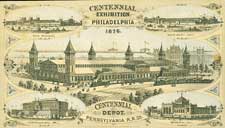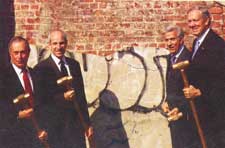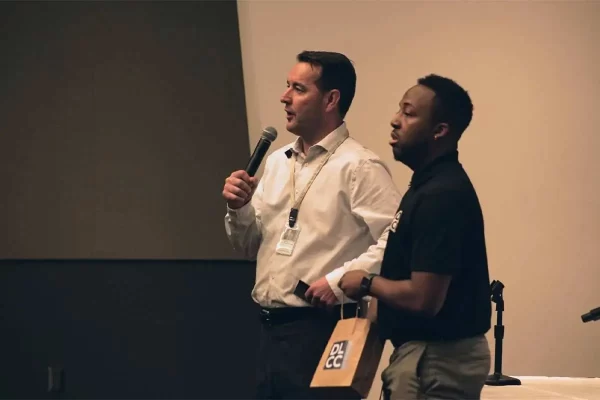Events and interesting facts that have shaped the industry
Highlights from the month of November 1876 – The first world’s fair in the U.S.
1876 – The first world’s fair in the U.S.
Officially known as the International Exhibition of Arts, Manufactures and Products of the Soil and Mine, the Centennial Exhibition of 1876 was the first major world’s fair to be held in the United States. The Centennial celebrated the 100th anniversary of the Declaration of Independence and showcased the United States as a rapidly developing industrial power with abundant natural resources. Nearly 10 million people visited the Centennial from May 10 to November 10, 1876, a staggering feat of cultural tourism when one considers the U.S. population totaled just 40 million at the time.
1907 – The most colossal failure in the history of exhibitions
The Jamestown Ter-Centennial Exposition, marking the three hundredth anniversary of the founding of the Jamestown colony by settlers from England, was held in Norfolk, Virginia, from April 26 to November 30, 1907. Among many dignitaries who visited the exposition were U.S. President Theodore Roosevelt andauthor Mark Twain.
The event earned only $1,070,149 against its projected revenue of $3,780,000. The financial problems led to the director’s resignation mid-festival—an event that, in turn, led to a tiff between the festival board and President Roosevelt. A day after it closed, the New York Times called the 1907 Jamestown Ter-Centennial Exposition “the most colossal failure in the history of exhibitions.”
1935 – Bayonets may have stopped a riot
The U.S. Marine Band and Color Guard marched into the Plaza del Pacifico to mark the opening of the California Pacific Exposition in San Diego on the morning of May 29, 1935. Unlike the Marines, children paid 25 cents and adults 50 cents each to get in.
Corporal Joe Galli of the 30th Infantry brought the first season to a close at midnight on Armistice Day, November 11, by playing Taps. As soon as the last poignant notes had died, a technician turned off seven fingers of lights on top the Organ Amphitheater. The 76,033 people who were present did not engage in riots, as they did when the 1934 Chicago Century of Progress Exposition closed. It was suspected that San Diego Exposition directors feared a repeat of the Chicago disorder, so they had soldiers of the 30th Infantry present, wearing steel helmets and carrying fixed bayonets.
Tradeshow History reported by Exhibit City News
1997 – NISCA files antitrust lawsuit
Nevada Independent Service Contactors Association (NISCA) filed an antitrust lawsuit against a long list of companies including GES, Freeman, several show managers and Teamsters Local 631. The NISCA claimed the defendants conspired to preclude its members from providing their convention services to tradeshow exhibitors. NISCA hired the services of Jeffrey Jacobovitz, an antitrust specialist from Washington D.C. and Gregory Kramer, a Las Vegas lawyer to represent them.
NISCA also listed CB Display Service, Czarnowski, EIS, Nth Degree, Renaissance, Sho Aids and Zenith.
NISCA companies told Exhibit City News that they had calculated revenue losses to be in excess of $100,000.
 2003 – Fabric: Fluid, Friendly, Fantastic
2003 – Fabric: Fluid, Friendly, Fantastic
A quick glance around the showfloor – any showfloor – tells the first time visitor what the rest of us already know; fabric is an important part of the current tradeshow environment. And there’s no evidence that this is a temporary phenomenon.
The acknowledged pioneer in the field, Moss Inc., of Belfast, Maine transitioned the use of fabric from banners and backdrops to exhibit spaces when the original owners of the company, Marilyn and Bill Moss were forced to explore cost effective ways to display their backpacking tents at tradeshows.
No story about fabric would be complete without mentioning Mary Carey. Hired by Moss to help with work for the 1984 Olympics, Carey, a designer who wanted to bring art to the industry, spend 10 years selling the concept of “fabric” to the exhibit builder and supplier community.
2006 – Construction begins at expanded Javits Center
As construction continued on the expanded Jacob Javits Convention Center, tourism leaders praised New York’s leadership for paving the way toward a new wave of convention business.

When completed in 2010, the Javits Center’s exhibition space will expand from 760,000 to 1.1million square feet, representing a 45 percent increase. Meeting room space will increase by 600 percent, from 30,000 to 210,000 square feet.
“The expansion will launch a new era for New York’s $24 billion travel and tourism sector,” said NYC & Company Chairman Jonathan M Tisch.
MoreTradeshow History
| Home |
| People on the Move |
| National News |
| Regional News |
| Features |
| Tradeshow Calendar |































